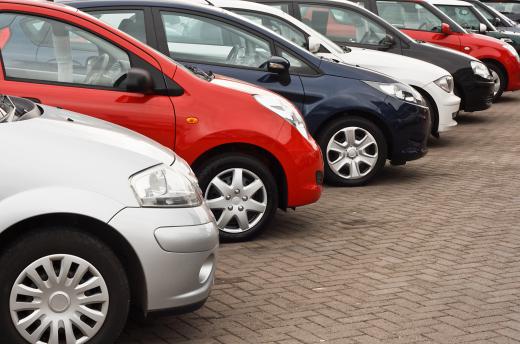MSRP, or Manufacturer Suggested Retail Price, is the selling price that a manufacturer recommends for its products. It is also sometimes referred to as the list price, and is most commonly associated in the car industry. Manufacturer prices are used for marketing by retail businesses and for comparison shopping by consumers.
Setting Prices

Any product can be given an MSRP, although they are especially common for automobiles, electronics, appliances, and other higher price goods. Because it is set by the manufacturer, it does not change at different stores or locations. The price is meant to reflect the costs involved in manufacturing and selling the product, and in most cases, an average mark-up by retailers is taken into account. Suggested prices are set so that each participant in the selling process — the manufacturer, the wholesaler, and the retailer — can make a profit from the final sale. If the MSRP is set too low, and the retailer feels it cannot make enough money from selling the item, it may choose not to carry it.
How Suggested Prices Are Used

As the costs of selling an item vary, retailers usually don't have to stick to the suggested price and can charge more if they want to. Since most consumers can easily find out the suggested price, even when it's not printed directly on the package as many are, charging more can give the impression that a store is overpriced. A manufacturer may set a minimum selling price, however, that retailers must comply with. This is particularly common with products that are in demand or intended to be exclusive.

MSRP began as a method of standardization. With a suggested price set by the manufacturer, all businesses and customers start off knowing the standard price for the item. In most cases, a retailer can then charge customers more or less than this amount, and often uses it as a promotional tool. During a sale, for example, a store might advertise that all washing machines are being sold for 10% less than MSRP, implying that this is a significant discount for consumers. Many online businesses regularly contrast an item's list price with how much the site charges to suggest that the store offers low prices.
Buying a New Car

US car dealerships are required to include the MSRP of each new car on the window sticker (also known as a Monroney sticker). This "sticker price" is the base price of the car, and does not include any optional equipment or destination charges, which is the cost of transporting the car to the dealership. These extra costs are usually listed separately on the sticker. Taxes and registration fees are not listed.

The MSRP is not how much the dealership paid the manufacturer for the car, called the dealer's invoice price. Consumers can often find invoice prices online, and knowing this information may help them when negotiating with seller over the final price of a car. It's important to note that even standard invoice prices are not always an accurate representation of what the dealer paid because the manufacturer may provide incentives or holdbacks — usually a percentage of the MSRP that's refunded to the dealer when the car sells — to encourage the sale of certain cars.
Car Discounts and Negotiation
While most people expect to get a discount off the suggested retail price of a car, when all of the extraneous charges are added in, the final amount due might be close to, or even higher than, the price set by the manufacturer. The suggested price used to be set fairly high to allow the dealer to offer a good-sized discount and let the buyer feel like he or she was getting a bargain. In recent years, the trend has tended towards the manufacturer setting the price closer to the actual market value.
Many car buyers use the difference between the MSRP and the invoice price to negotiate down the cost of buying a new car. This may be even more successful if the buyer has a good idea of which cars are less in demand, and therefore more likely to include incentives and holdbacks for the dealer. Knowing what the dealership actually paid can help a buyer get an even better deal, although he or she should remember that the dealer needs to make some profit on the sale.
A number of dealerships also promote no-negotiation sales, suggesting that their prices are more fair so there's no need to haggle. Models that are very popular or that have little competition are also less likely to be available for below MSRP, since the consumer doesn't have much choice other than what's being offered. Depending on the model and the demand, it is not unusual to pay full price plus additional charges at some dealerships.
Used Cars
Used cars do not have an MSRP because the value of the car changes once it has been sold. The original price of the car can often be found through online directories or by contacting the dealership, and several companies offer estimates on what might be considered a fair price for a used car in different conditions. Buyers may want to consider the original manufacturer's price as a way of comparing how a car has held its value over time.
- https://www.cars.com/articles/what-does-msrp-mean-1420690419467/
- https://www.carsdirect.com/car-pricing/msrp-vs-invoice-price-what-is-the-difference
- https://www.dmv.org/buy-sell/new-cars/reading-window-stickers.php
- https://www.edmunds.com/car-buying/dealer-holdback/
- https://www.investopedia.com/terms/m/manufacturers-suggested-retail-price-msrp.asp
